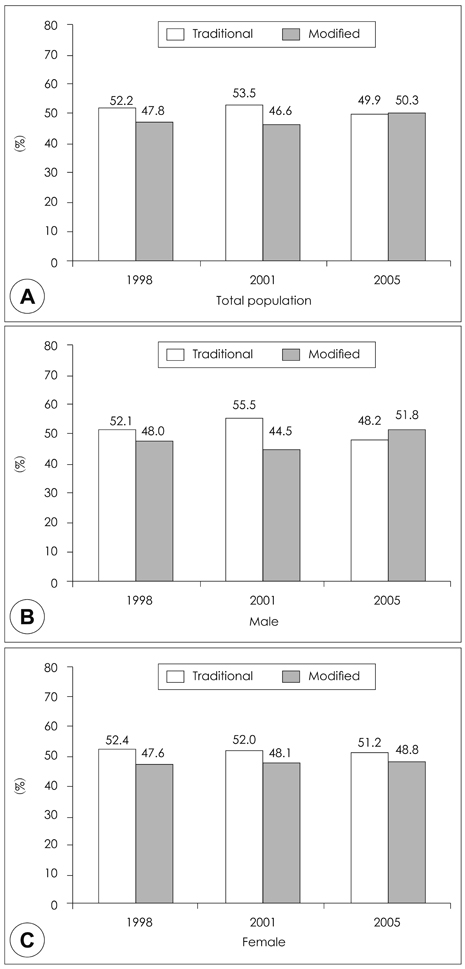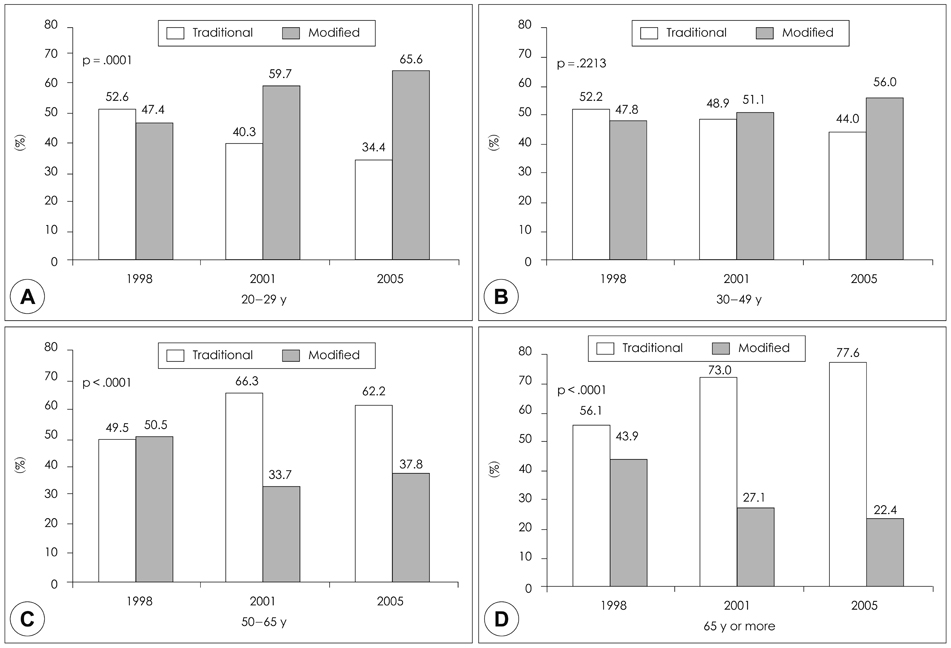Secular Trend in Dietary Patterns in a Korean Adult Population, Using the 1998, 2001, and 2005 Korean National Health and Nutrition Examination Survey
- Affiliations
-
- 1Department of Food & Nutrition, Seoul National University, Seoul 151-742, Korea.
- 2School of Public Health, Seoul National University, Seoul 151-742, Korea.
- 3Department of Food Service and Nutrition Care, Seoul National University Hospital, Seoul 110-799, Korea.
- 4Major of Food & Nutrition, School of Human Ecology, Catholic University of Korea, Bucheon 420-743, Korea. yjsong@catholic.ac.kr
- KMID: 2268473
- DOI: http://doi.org/10.4163/kjn.2011.44.2.152
Abstract
- Koreans have undergone many changes in dietary patterns with economic growth. The purpose of this research was to examine changes in dietary patterns using data from the 1998, 2001, and 2005 Korean National Health and Nutrition Examination Survey. The study included 21,525 subjects (8,295 from 1998, 6,880 from 2001, and 6,350 from 2005) who were 20 years or older and who participated in a 24-h diet recall. The percentage energy intake from 22 food groups was calculated, and a cluster analysis was applied to identify dietary patterns. Two dietary patterns emerged; the first pattern was characterized by high intake of white rice, legumes, vegetables, kimchi, and seaweeds, the so-called "traditional" pattern (53%), whereas the other pattern was characterized by high intake of other grains, noodle dumplings, floured bread, pizza, hamburgers, cereals and snacks, potatoes, sugared sweets, nuts, fruits, meat.its products, eggs, fish, milk and dairy products, oils, beverages and seasoning, or the so-called "modified" pattern. The modified pattern comprised a higher proportion of younger aged, metropolitan residents with more education and higher incomes. However, the gender distribution was not significantly different. The modified pattern had a significantly higher intake of all nutrients except carbohydrates and had a higher proportion of energy from fat and protein. No association with a risk for metabolic syndrome was found for either dietary pattern. After age was standardized, the traditional pattern included 52% of the respondents in 1998, 54% in 2001, and 50% in 2005. However, the modified pattern was significantly more prevalent in the younger age group (20-29 yr), whereas the traditional pattern increased significantly in the older age group (> or = 65 yr). In conclusion, a secular trend was found for dietary pattern by age group, suggesting that it is necessary to monitor the changes in dietary pattern by age group and to develop appropriate dietary education and guidelines.
Keyword
MeSH Terms
-
Adult
Aged
Beverages
Bread
Carbohydrates
Cluster Analysis
Dairy Products
Diet
Economic Development
Edible Grain
Eggs
Energy Intake
Fabaceae
Flour
Fruit
Humans
Milk
Nutrition Surveys
Nuts
Oils
Organothiophosphorus Compounds
Ovum
Seasons
Snacks
Solanum tuberosum
Surveys and Questionnaires
Vegetables
Carbohydrates
Oils
Organothiophosphorus Compounds
Figure
Cited by 10 articles
-
Regional disparities in the associations of cardiometabolic risk factors and healthy dietary factors in Korean adults
Kyungho Ha, YoonJu Song, Hye-Kyeong Kim
Nutr Res Pract. 2020;14(5):519-531. doi: 10.4162/nrp.2020.14.5.519.Risk of Metabolic Syndrome according to Intake of White Rice and Kimchi in Korean Adults: based on the 6th Korea National Health and Nutrition Examination Survey, 2013–2015
Jin-Su Kim, So Hyun Ahn, Sook Mee Son
Korean J Community Nutr. 2018;23(6):525-537. doi: 10.5720/kjcn.2018.23.6.525.The framingham risk score, diet, and inflammatory markers in Korean men with metabolic syndrome
Cheongmin Sohn, Juyong Kim, Wookyung Bae
Nutr Res Pract. 2012;6(3):246-253. doi: 10.4162/nrp.2012.6.3.246.Development of Korean Healthy Eating Index for adults using the Korea National Health and Nutrition Examination Survey data
Sung-Min Yook, Sohee Park, Hyun-Kyung Moon, Kirang Kim, Jae Eun Shim, Ji-Yun Hwang
J Nutr Health. 2015;48(5):419-428. doi: 10.4163/jnh.2015.48.5.419.Developing and testing the reliability of a measurement tool for an urban area food environment in Korea – Focusing on food stores -∗
Mi Jin Jang, Sangah Shin, Seong-Ah Kim, Sangwon Chung, Hee Young Paik, Jeong-sook Choe, Eun Joo Hong, Hyojee Joung
J Nutr Health. 2014;47(5):351-363. doi: 10.4163/jnh.2014.47.5.351.Comparative analysis of dietary behavior and nutrient intake of elderly in urban and rural areas for development of “Village Lunch Table” program: Based on 2014 Korea National Health and Nutrition Examination Survey data
Youngmi Lee, Yourim Choi, Hae Ryun Park, Kyung Hee Song, Kyung Eun Lee, Yoo Chang Hee, Young Suk Lim
J Nutr Health. 2017;50(2):171-179. doi: 10.4163/jnh.2017.50.2.171.Risk of Metabolic Syndrome according to Intakes of Vegetables and Kimchi in Korean Adults: Using the 5th Korea National Health and Nutrition Examination Survey, 2010–2011
Jae-Eun Yoo, Jin-Su Kim, Sook Mee Son
Korean J Community Nutr. 2017;22(6):507-519. doi: 10.5720/kjcn.2017.22.6.507.Economic Burden of Cancer in Korea during 2000-2010
Kwang-Sig Lee, Hoo-Sun Chang, Sun-Mi Lee, Eun-Cheol Park
Cancer Res Treat. 2015;47(3):387-398. doi: 10.4143/crt.2014.001.Regional disparities related to cardiovascular diseases and diet quality in Korean adults: based on the 2013–2016 Korea National Health and Nutrition Examination Survey Data
Bo Young Seo, Eun Sil Her
Nutr Res Pract. 2022;16(6):755-764. doi: 10.4162/nrp.2022.16.6.755.Eating Alone and Metabolic Syndrome: A Population-Based Korean National Health and Nutrition Examination Survey 2017-2019
Jeongmin Lee, Minwoo Hyun, Youngsung Suh, Daehyun Kim, Seungwan Hong
Korean J Health Promot. 2022;22(3):123-130. doi: 10.15384/kjhp.2022.22.3.123.
Reference
-
1. Paik HY. Dietary intakes and disease in Korean. 1997. Seoul: Seoul National University.2. In-Depth Analysis on the 3rd (2005) Korea Health and Nutrition Examination Survey - Nutrition Survey -. 2007. Korea Health Industry Development Institute.3. Lee HS, Kim BH, Jang YA, Kim CI. 2001 Korean National Health and Nutrition Examination Survey -The change of dietary intakes and the intakes of fat. In : Proceedings of 26th Korean Soc Lipid Atherosclerosis conference; 2003. Sep. 26-27.; Seoul, Korea.4. Yoon KH. Comparisons of dietary atherogenicity and nutrient intakes between college students and their parents. Korean J Food Nutr. 2000. 13(2):111–117.5. Kant AK, BI Graubard. Secular trends in patterns of self-reported food consumption of adult Americans: NHANES 1971-1975 to NHANES 1999-2002. Am J Clin Nutr. 2006. 84(5):1215–1223.
Article6. Valdes J, Grau M, Subirana I, Marrugat J, Covas MI, Schroder H. Secular trends in energy intake and diet quality in a Mediterranean population. Ann Nutr Metab. 2009. 54(3):177–183.
Article7. Zhai F, Wang H, Du S, He Y, Wang Z, Ge K, Popkin BM. Lifespan nutrition and changing socio-economic conditions in China. Asia Pac J Clin Nutr. 2007. 16:Suppl 1. 374–382.8. Newby PK, Tucker KL. Empirically derived eating patterns using factor or cluster analysis: a review. Nutr Rev. 2004. 62(5):177–203.
Article9. Kant AK. Dietary patterns and health outcomes. J Am Diet Assoc. 2004. 104(4):615–635.
Article10. Mishra GD, McNaughton SA, Bramwell GD, Wadsworth ME. Longitudinal changes in dietary patterns during adult life. Br J Nutr. 2006. 96(4):735–744.11. Weismayer C, JG Anderson, A Wolk. Changes in the stability of dietary patterns in a study of middle-aged Swedish women. J Nutr. 2006. 136(6):1582–1587.
Article12. Borland SE, Robinson S M, Crozier SR, Inskip HM. Stability of dietary patterns in young women over a 2-year period. Eur J Clin Nutr. 2008. 62(1):119–126.
Article13. Song Y, Park MJ, Paik HY, Joung H. Secular trends in dietary patterns and obesity-related risk factors in Korean adolescents aged 10-19 years. Int J Obes (Lond). 2010. 34(1):48–56.
Article14. National health and nutrition examination survey report 1998. 1999. Ministry of Health and Welfare.15. National health and nutrition examination survey report 2001. 2002. Ministry of Health and Welfare.16. National health and nutrition examination survey report 2005. 2006. Ministry of Health and Welfare.17. Grundy SM, Cleeman JI, Daniels SR, Donato KA, Eckel RH, Franklin BA, Gordon DJ, Krauss RM, Savage PJ, Smith SC, Spertus JA, Costa F. Diagnosis and management of the metabolic syndrome: an American Heart Association/National Heart, Lung, and Blood Institute scientific statement: Executive summary. Crit Pathw Cardiol. 2005. 4(4):198–203.18. Song YJ, Paik HY, Joung HJ. A comparision of cluster and factor analysis to derive dietary patterns in Korean adults using data from the 2005 Korea national health and nutrition examination survey. Korean J Community Nutr. 2009. 14(6):722–733.19. Song YJ, Joung HJ, Paik HY. Socioeconomic, nutrient, and health risk factors associated with dietary patterns in adult population from 2001 Korean national health and nutrition survey. Korean J Nutr. 2005. 38(3):219–225.20. Park SH, Lee KS, Park HY. Dietary carbohydrate intake is associated with cardiovascular disease risk in Korean: Analysis of the third Korea national health and nutrition examination survey (KNHANES III). Int J Cardiol. 2010. 139(3):234–240.
Article21. Choi J, Se-Young O, Lee D, Tak S, Hong M, Park SM, Cho B, Park M. Characteristics of diet patterns in metabolically obese, normal weight adults (Korean national health and nutrition examination survey III, 2005). Nutr Metab Cardiovasc Dis. 2010. doi: 10.1016/j.numecd.2010.09.001.
Article22. Wirfalt AK, RW Jeffery. Using cluster analysis to examine dietary patterns: nutrient intakes, gender, and weight status differ across food pattern clusters. J Am Diet Assoc. 1997. 97(3):272–279.23. van Dam RM, Rimm EB, Willett WC, Stampfer MJ, Hu FB. Dietary patterns and risk for type 2 diabetes mellitus in US men. Ann Intern Med. 2002. 136(3):201–209.
Article24. Sadakane A, Tsutsumi A, Gotoh T, Ishikawa S, Ojima T, Kario K, Nakamura Y, Kayaba K. Dietary patterns and levels of blood pressure and serum lipids in a Japanese population. J Epidemiol. 2008. 18(2):58–67.
Article
- Full Text Links
- Actions
-
Cited
- CITED
-
- Close
- Share
- Similar articles
-
- Socioeconomic, Nutrient, and Health Risk Factors Associated with Dietary Patterns in Adult Populations from 2001 Korean National Health and Nutrition Survey
- Trends in energy intake among Korean adults, 1998-2015: Results from the Korea National Health and Nutrition Examination Survey
- Dietary Pattern by Sex and Age with Menu Analysis Using 1998, 2001 National Health and Nutrition Survey of Korea
- Trends in the major dish groups and food groups contributing to sodium intake in the Korea National Health and Nutrition Examination Survey 1998-2010
- A Comparison of Cluster and Factor Analysis to Derive Dietary Patterns in Korean Adults Using Data from the 2005 Korea National Health and Nutrition Examination Survey



